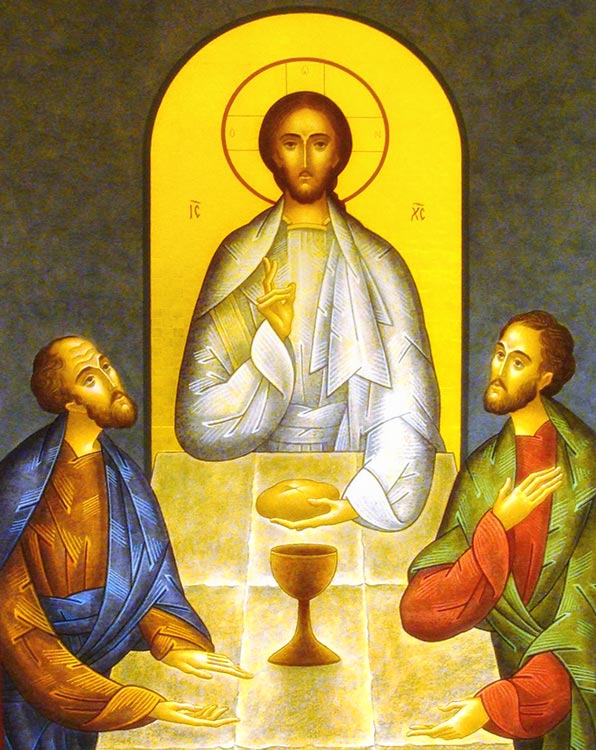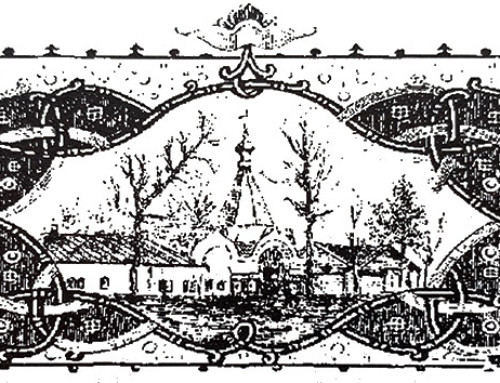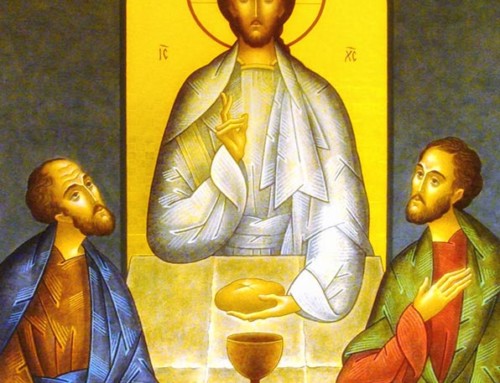Catechetical Sermon on the Divine Liturgy
#9 The Creed: “No one may share the Eucharist with us unless he believes that what we teach is true.”
After the prayer of the aitesis, the priest again greets/”blesses” the congregation, signaling that a new section of the Liturgy has begun: the kiss of peace and the profession of faith.
There is a strong organic unity between the bond of peace among the believers and the profession of our beliefs. If we are not at peace with each other, our profession of faith is a fraud because Jesus insisted (Matthew 5:23), if we approach the altar with our gift and remember that our brother or sister has something against us (i.e. that we have offended them), we should leave our gift right there and go first and be reconciled. The external gesture of this love is the kiss of peace, a most ancient custom among Christians, which is mentioned at least four times by St. Paul in Scripture, the first instance being in Romans 16:16. So the deacon exclaims, “Let us love one another, so that in unity of heart we may proclaim;” and the people complete it by singing, “the Father and the Son, and the Holy Spirit, the Trinity one in substance and undivided.”
Our attestation of belief in God is counterfeit unless—like God, in whose image we are made—we love each other, and so we refer to the Trinity, a community of mutual and undivided love. Today, however, the kiss itself is usually exchanged only by the clergy; and even then it is often done during the recitation of the creed for convenience. The deacon’s exclamation, “The doors! The doors! In wisdom, let us be attentive!” was originally the signal to lock the doors of the church and thus open the heart and soul of the Mystery to those permitted to participate, but today it simply signals the recitation of the creed.
The creed was introduced into the Liturgy by the Monophysites in 476 AD as a sign of their devotion to the Council of Nicaea, and was later authorized for the orthodox by Patriarch Timothy. There is a claim that a bishop of Antioch, Peter Knapfeos, introduced it in his church after that. This is the most fundamental statement of our beliefs and faith, made to enable the community to be of one heart and mind in Jesus (Cf. Philippians 4:7). The ancient name for the creed, “the symbol of faith,” points directly to that; the Greek word symbole means to” bring together.”
During the recitation of the creed, the large cover over both dish and cup is picked up and held over the offering. This gesture originated in the Middle Ages when the aer (today the size of a large handkerchief) was the size of the Good Friday burial shroud of the Lord. It took several ministers to lay it over the offering, and then to remove it. Today, when a bishop serves, several of the presbyters will hold it over his head like a canopy during the creed. This is a “freeze frame” in the process of laying the aer on the gifts of bread and wine, or taking it off later. (Even when a group of priests serve together, they will hold the aer over the gifts like that; and if a priest serves alone today he will hold it by its upper corners and let it hang in front of his face.) Liturgical commentators have assigned symbolic meaning to this gesture, but it began—and remains at heart—a simple necessity, to get a very large cloth from behind the bishop onto the gifts lying before him, and later removing it, without knocking anything over.
Катехетична Проповідь про Божественну Літургію
#9 Символ віри: «Не може приймати Євхаристію спільно з нами той, хто не вірить у те, що ми навчаємо».
Після молитви єктенії, священик знову благословляє спільноту, вказуючи на те, що розпочалася нова частина Літургії поцілунком миру та визнанням віри.Існує міцний зв’язок між зв’язком миру серед віруючих та визнанням віри. Якщо ми не живемо у мирі одні з одними, наше визнання віри – це шахрайство, адже Ісус наполягає (Мт. 5:23), якщо ми стоїмо перед вівтарем з нашим даром і пам’ятаємо, що наш брат чи сестра мають щось проти нас (тобто, що ми образили їх), ми повинні залишити свій дар там і йти спочатку примиритися з ними. Цей зовнішній жест любові є поцілунок миру, який є найдавнішим звичаєм серед християн, про що згадується щонайменше чотири рази Святим Павлом у Святому Письмі у Листі до Римлян 16:16. Отже, диякон виголошує: “Возлюбімо один одного, щоб однодумно визнавати”, і вірні завершують це, співаючи: “Отця, і Сина, і Святого Духа, Тройцю єдиносущну і нероздільну”. Наше свідчення віри в Бога матиме вартість лише тоді, коли ми уподібнюватимемося Богові, на чий образ ми створені, адже виявляючи любов один до одного, ми наслідуємо Трійцю, спільноту взаємної і нероздільної любові. Сьогодні, однак, лише духовенство обмінюється поцілунком миру під час молитви “Символу Віри”; і, навіть, тоді це часто робилося під час цієї молитви для зручності. Виголос диякона: “Двері! Двері! Премудрість, будьмо уважні!” – на початку було сигналом зачиняти двері церкви, і тим самим відкрити серце та душу на Таїнство для усіх тих, хто допускається до участі у ньому, але сьогодні це просто вказує на момент Символу Віри.
Символ віри було введено в Літургію монофизитами в 476 р. н.е., як знак їхньої відданості вченню Нікейського Собору, і пізніше було затверджено для православних вірних Патріархом Тимофієм. Існує твердження, що єпископ Антіохійський Пітер Кнапфеос після цього представив його у своїй церкві. Це найважливіші правди нашої віри, складені для того, щоб спільнота могла стати єдиним серцем та єдиним умом в Ісусі (пор. Филип’ян 4:7). Старовинна назва молитви «Вірую», “Символ віри”, прямо вказує на це; грецьке слово «символ» означає”об’єднувати”.
Під час промовляння Символу Віри, великий покровець для чаші та дискоса, підноситься вгору та тримається. Цей жест зародився в середньовіччі, коли покрівець, який сьогодні відповідає розміру великої хустини був розміром плащаниці Господа у Велику П’ятницю. Це вимагало участі кількох священослужителів, щоб покласти його на вівтар, а потім його зняти. Сьогодні, коли служить єпископ, деякі з пресвітерів тримають цей покрівець над головою під час Символу Віри. Якщо група священиків служитиме разом, вони будуть тримати покрівець над дарами, і якщо священик буде служити сьогодні сам, він буде тримати його за верхні кути перед своїм обличчям над дарами. Літургісти приписують цьому жесту символічне значення, але це почалося, і залишається через просту практичну необхідність придбати дуже велику тканину, щоб прикрити дари та єпископа, який нахиливши голову над дарами, що лежать перед ним, а потім забрати її, нічого не перекинувши на престолі.



